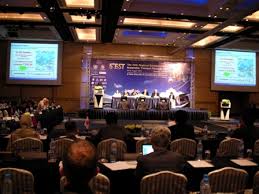By Katsuhiro Asagiri
BANGKOK (INPS Japan/IDN) – Asia-Pacific already has the largest number of motorized vehicles in the world and if the present trend continues, the region would in the coming years have more automobiles than Europe and North America combined.
In Japan alone, the number of vehicles has swelled from 8.12 million in 1966 to 78 million in 2009. Of these 54 percent are passenger vehicles, 34 percent light-duty vehicles, and 8 percent trucks. The rest are motorcycles and buses.

At the same time, the number of logistic companies has been rising. “Presently, we have about 60,000 logistic companies, which is a 50 percent increase on the 1990s,” said Keiji Endo, General Manager of the Tokyo Trucking Association. He was addressing the Fifth Regional Environmentally Sustainable Transport (EST) Forum in Asia from August 23 to 25 in Bangkok, Thailand. It was attended by senior government officials from 22 Asian countries and international transportation experts. JAPANESE
The Forum was organized by the United Nations Centre for Regional Development (UNCRD), Thailand’s Ministry of Natural Resources and Environment (MONRE), Japan’s Ministry of the Environment, and the United Nations Economic and Social Commission for Asia (UN ESCAP).
Endo pointed out that 99 percent of the companies in Japan own less than 100 trucks, and 76 percent of all the companies are small-scale enterprises owning less than 20 vehicles.
According to the national Automobile NOx /PM Law, aimed at curbing nitrogen oxide and particulate matter emissions, large trucks that are more than nine years old and small ones older than eight years are not allowed to be on the road since 2003, regardless of how many kilometers they have covered. This is part of a rather stringent law that seeks to control emissions from automobiles operated by small and medium-sized companies.
In Tokyo, according to a more stringent regulation, a vehicle older than seven years must either install a diesel particulate matter filter (DPF) or buy a new automobile. Those who violate this regulation are penalized.
As a result of this directive, all measurement stations in Tokyo had confirmed that the pollution level had been improved upon 2005. The air became cleaner and cleaner, and the sky is looking blue.
However, small and medium-sized companies had to pay a heavy price for this regulation. They were forced to buy a costly DPF or a brand new truck. As a result, the membership of the Tokyo Trucking Association suffered a decline of 20 percent. Also the number of trucks had decreased by more than 20 percent since 2003.
‘The Revised Energy Conservation Law’ is another tool to protect environment. This law obliged trucking companies to regularly report their CO2 emissions. “But small enterprises are not in a position to collect and control such data, particularly as 99 percent of trucking companies are small and medium-sized,” said Endo.
ECO-DRIVING
Against this backdrop, the Tokyo Trucking Association decided to start a new project. Environmentally friendly driving called Eco-driving became the centre-piece of the project underlining Corporate Social Responsibility of logistic enterprises for environment.
According to a survey, the practice of Eco-driving resulted in the reduction of nitrogen oxides emissions by 15 percent and CO2 emissions by 20 percent.
The Green-Eco project has four key aspects: sustainability; reasonable costs; accuracy of data collected; and, above all, the activities should be such that drivers are kept motivated.
The practical tools deployed, surprisingly, are not internet-based:
— Posters and stickers for members to share their motivations with each other.
— Writing data in the check list by hand because it is an economic way of record keeping.
— By keeping track of such sheets, each member can easily see improvements of fuel efficiency and reductions in traffic accidents.
— Eco-driving education
— Giving recognition to good drivers as a means of motivation
— Involving managers in the project on an equal footing
— Professional handling of the collected data.
— Seminars for managers seven times a year.
Endo reported that the project had made great strides: member participation has been on the rise every year. In March 2010, over 500 companies and 11,000 vehicles participated in the Green-Eco project.
In addition, fuel consumption was reduced over the past four years — the fuel saved was equivalent to what would have been used by 500 large-sized tank trucks. The savings were worth some about 880 million Japanese Yen (some 9.53 million U.S. dollars).
The reduction of fuel consumed implied a reduction in 20,000 tons CO2 emissions. Also the number of traffic accidents declined by 40 percent over a period of four years.
“We can say that this Project has made a great achievement not only in terms of national economy but also of the society as a whole,” Endo told the Bangkok Forum, adding that the next step would be to benchmark fuel efficiency database for each type of vehicle.
“In Japan, we have many advanced devices to support the practice of Eco-driving, such as Digital Taco-graph or Drive recorders,” said.
However, the Green-Eco Project neither requires huge financial investment nor high-tech. All that it needs is a piece of paper called Driving Management Sheet, and a pen to start with — and all this to protect the environment, reduce fuel costs, bring about a decrease in the number of traffic accidents and foster better communication among company co-workers.
Endo is looking forward to expanding this project to cover whole of Japan. In view of the fact that it is a low-budget and paper-pencil-oriented project, he hopes to find interested parties in other Asian countries too, which might like to gain from Green-Eco experiences in Tokyo.(INPS Japan/ IDN-InDepthNews/25.08.2010)





